Why is my Panasonic Air Conditioner outdoor unit emitting water or steam?
- Mmark39Aug 3, 2025
The water or steam emitted from the outdoor unit of your Panasonic Air Conditioner is due to condensation or evaporation occurring on the pipes.
Why is my Panasonic Air Conditioner outdoor unit emitting water or steam?
The water or steam emitted from the outdoor unit of your Panasonic Air Conditioner is due to condensation or evaporation occurring on the pipes.
Why does my Panasonic CS-YE18MKE Air Conditioner start automatically after a power failure?
The Panasonic Air Conditioner is equipped with an Auto Restart function. If the power is interrupted and then restored, the unit will automatically resume operation using the previous settings (operation mode and air flow direction), as long as the operation was not stopped by remote control.
Why does mist emerge from my Panasonic CS-YE18MKE indoor unit?
The mist emerging from the indoor unit of your Panasonic Air Conditioner is a condensation effect that occurs due to the cooling process.
Why is there a delay when I restart my Panasonic CS-YE18MKE?
The operation delay after restarting your Panasonic Air Conditioner is a built-in protection mechanism for the unit's compressor.
Why does my room have a peculiar odor when using my Panasonic Air Conditioner?
The peculiar odor in the room when using your Panasonic Air Conditioner may be due to a damp smell emitted by the wall, carpet, furniture, or clothing.
Why does the indoor fan stop sometimes on my Panasonic CS-YE18MKE during automatic fan speed?
The indoor fan in your Panasonic Air Conditioner stops occasionally during automatic fan speed setting to help remove surrounding odors.
Why is the pressure low during heating mode in my Panasonic CS-YE18MKE?
Low pressure during heating mode in your Panasonic Air Conditioner may be due to an inefficient compressor, insufficient refrigerant, or a clogged strainer or capillary cube.
Safety warnings and precautions for operating and handling the indoor and outdoor units.
Precautions to prevent injury or malfunction related to the remote control and its batteries.
Guidelines for safe electrical connection, handling of cords, and prevention of shocks or fires.
Instructions for using the POWER button to start or stop the air conditioner operation.
Details on selecting the desired temperature for cooling, heating, and dry modes.
Guide to choosing between AUTO, HEAT, COOL, and DRY operating modes.
Explanation of how to adjust the indoor fan speed, including AUTO setting.
How to control the louver swing for optimal air distribution in different modes.
Using the POWERFUL mode to reach the desired temperature faster.
Activating the QUIET mode to reduce airflow noise for a more peaceful environment.
How to reset the remote control to its original factory default settings.
Information on buttons or functions not typically used during normal air conditioner operation.
Instructions for setting the timer to automatically stop the unit after a specified period.
Instructions for setting the timer to automatically start the unit after a specified period.
How to set both a delayed stop and a delayed start for the air conditioner.
How to set a delayed start followed by a delayed stop for the unit.
Steps to activate and confirm the programmed timer operation.
How to deactivate or cancel any programmed timer settings.
Instructions for gently wiping the indoor unit with a soft, dry cloth.
Guide on how to remove, wash, and securely close the front panel of the indoor unit.
Identification of the receiver component on the indoor unit.
Information regarding the aluminium fin, with a safety warning.
How to manually adjust the horizontal louvers for airflow direction.
Note that the vertical louvers should not be adjusted by hand.
Explanation of the Auto Off/On button's operation when the remote control is unavailable.
Instructions for cleaning and maintaining the air filters for optimal unit performance.
Common operational behaviors that are not indicative of a malfunction.
Steps to take before calling for professional servicing to resolve issues.
Procedure for using the remote control to retrieve and diagnose error codes.
Details of indoor and outdoor unit models covered in the specifications.
Specifications for power, current, and refrigerant type and quantity.
Cooling and heating capacities for different unit models.
Specifications for noise levels during operation and air circulation rates.
Product weight and physical dimensions (Height x Width x Depth) for the units.
Standard test conditions for cooling and heating performance measurements.
Step-by-step guide for preparing the remote control by installing batteries correctly.
Guide to choosing between AUTO, HEAT, COOL, and DRY operating modes using the remote.
Instructions on how to use the OFF/ON button to start or stop the unit.
How to adjust the desired temperature using the TEMP buttons on the remote.
Safety warnings and precautions for operating and handling the indoor and outdoor units.
Precautions to prevent injury or malfunction related to the remote control and its batteries.
Guidelines for safe electrical connection, handling of cords, and prevention of shocks or fires.
Instructions for using the POWER button to start or stop the air conditioner operation.
Details on selecting the desired temperature for cooling, heating, and dry modes.
Guide to choosing between AUTO, HEAT, COOL, and DRY operating modes.
Explanation of how to adjust the indoor fan speed, including AUTO setting.
How to control the louver swing for optimal air distribution in different modes.
Using the POWERFUL mode to reach the desired temperature faster.
Activating the QUIET mode to reduce airflow noise for a more peaceful environment.
How to reset the remote control to its original factory default settings.
Information on buttons or functions not typically used during normal air conditioner operation.
Instructions for setting the timer to automatically stop the unit after a specified period.
Instructions for setting the timer to automatically start the unit after a specified period.
How to set both a delayed stop and a delayed start for the air conditioner.
How to set a delayed start followed by a delayed stop for the unit.
Steps to activate and confirm the programmed timer operation.
How to deactivate or cancel any programmed timer settings.
Instructions for gently wiping the indoor unit with a soft, dry cloth.
Guide on how to remove, wash, and securely close the front panel of the indoor unit.
Identification of the receiver component on the indoor unit.
Information regarding the aluminium fin, with a safety warning.
How to manually adjust the horizontal louvers for airflow direction.
Note that the vertical louvers should not be adjusted by hand.
Explanation of the Auto Off/On button's operation when the remote control is unavailable.
Instructions for cleaning and maintaining the air filters for optimal unit performance.
Common operational behaviors that are not indicative of a malfunction.
Steps to take before calling for professional servicing to resolve issues.
Procedure for using the remote control to retrieve and diagnose error codes.
Details of indoor and outdoor unit models covered in the specifications.
Specifications for power, current, and refrigerant type and quantity.
Cooling and heating capacities for different unit models.
Specifications for noise levels during operation and air circulation rates.
Product weight and physical dimensions (Height x Width x Depth) for the units.
Standard test conditions for cooling and heating performance measurements.
Step-by-step guide for preparing the remote control by installing batteries correctly.
Guide to choosing between AUTO, HEAT, COOL, and DRY operating modes using the remote.
Instructions on how to use the OFF/ON button to start or stop the unit.
How to adjust the desired temperature using the TEMP buttons on the remote.
| Brand | Panasonic |
|---|---|
| Model | CS-YE18MKE |
| Category | Air Conditioner |
| Language | English |



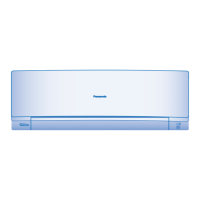
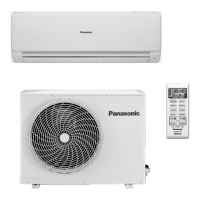
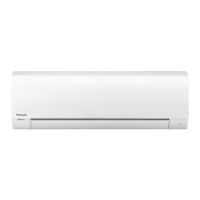
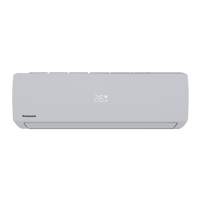
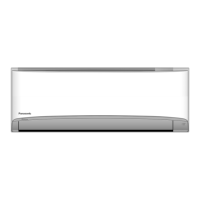



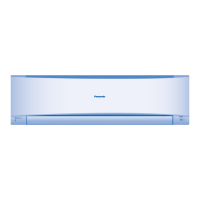
